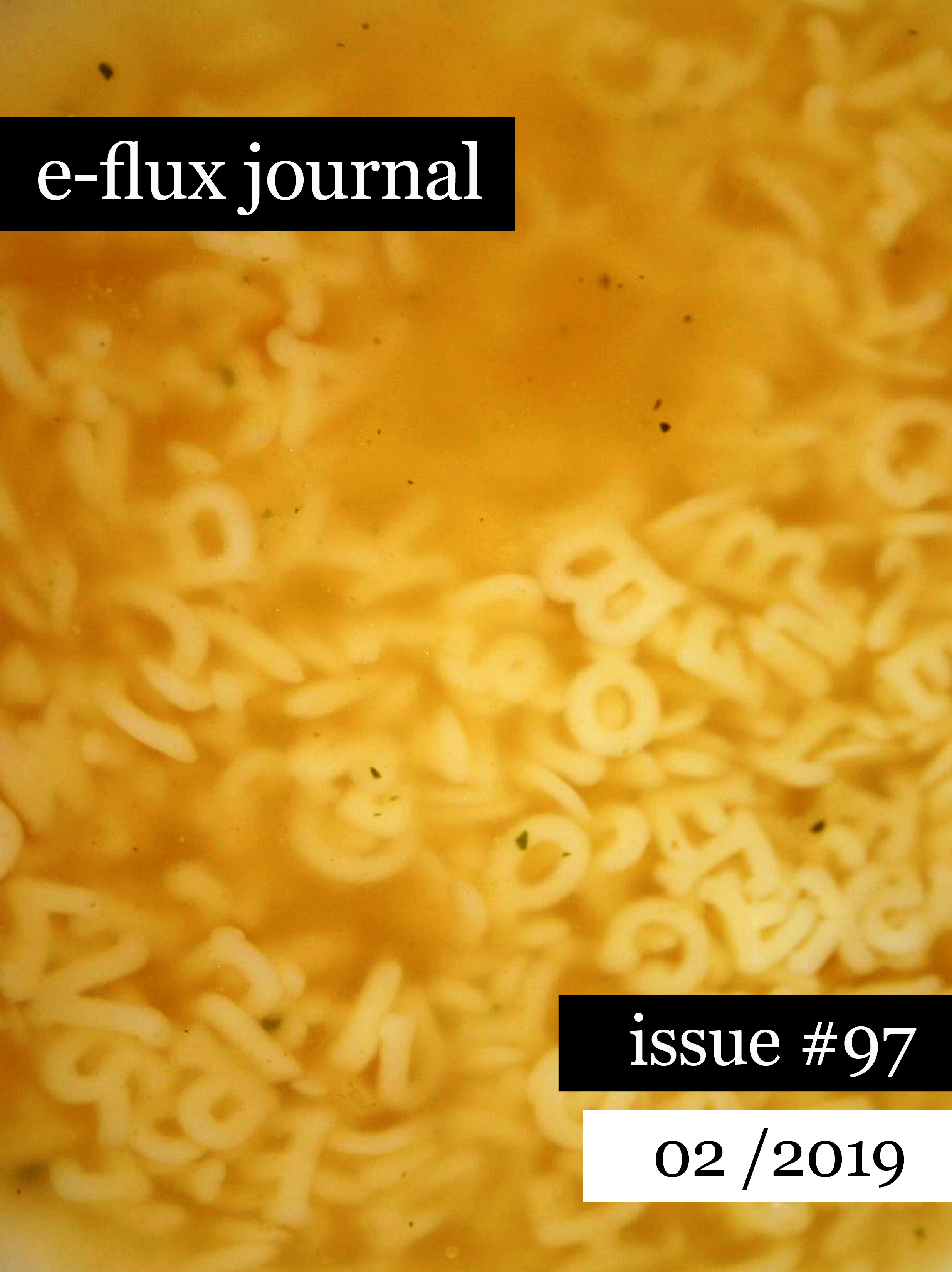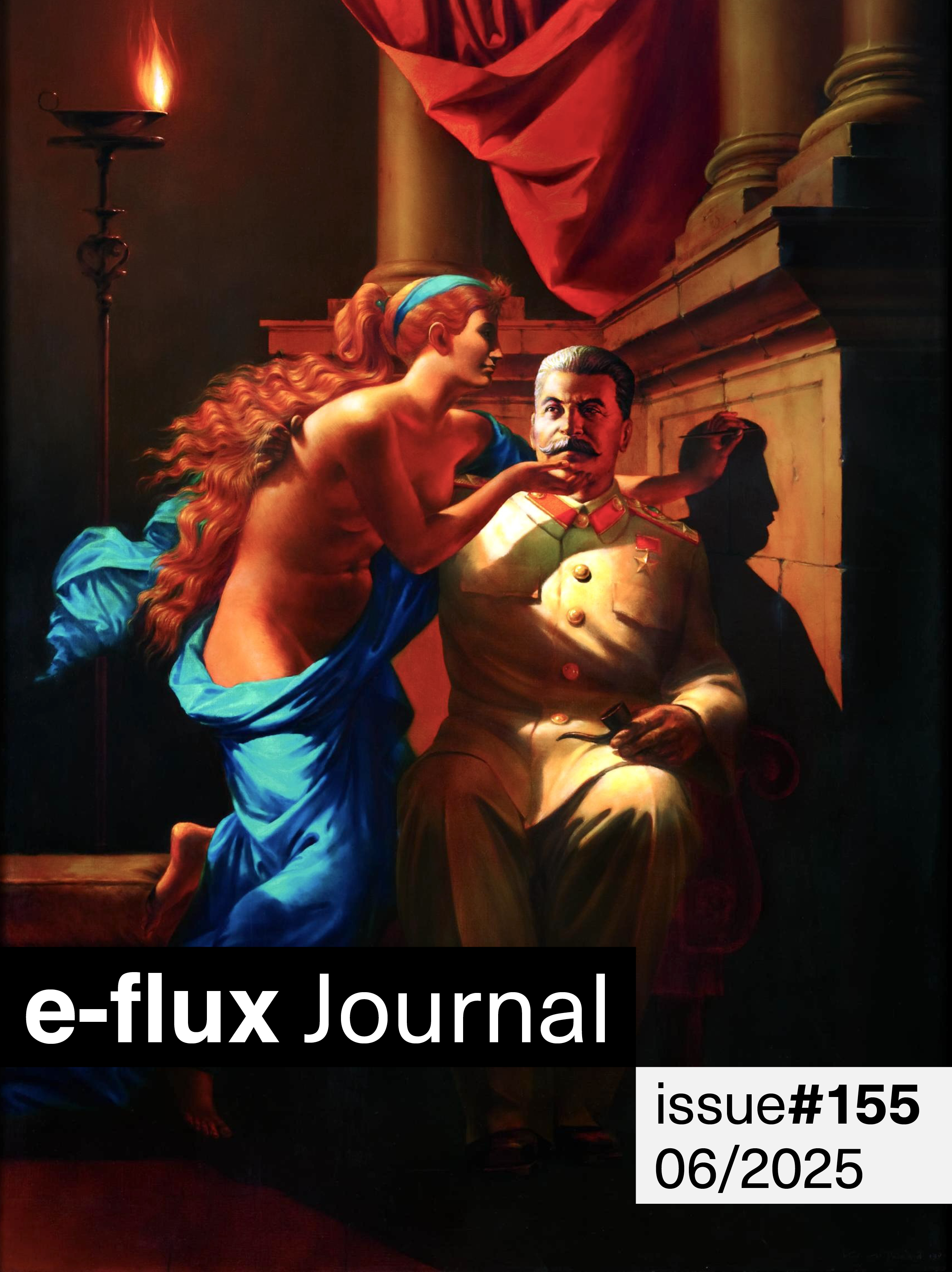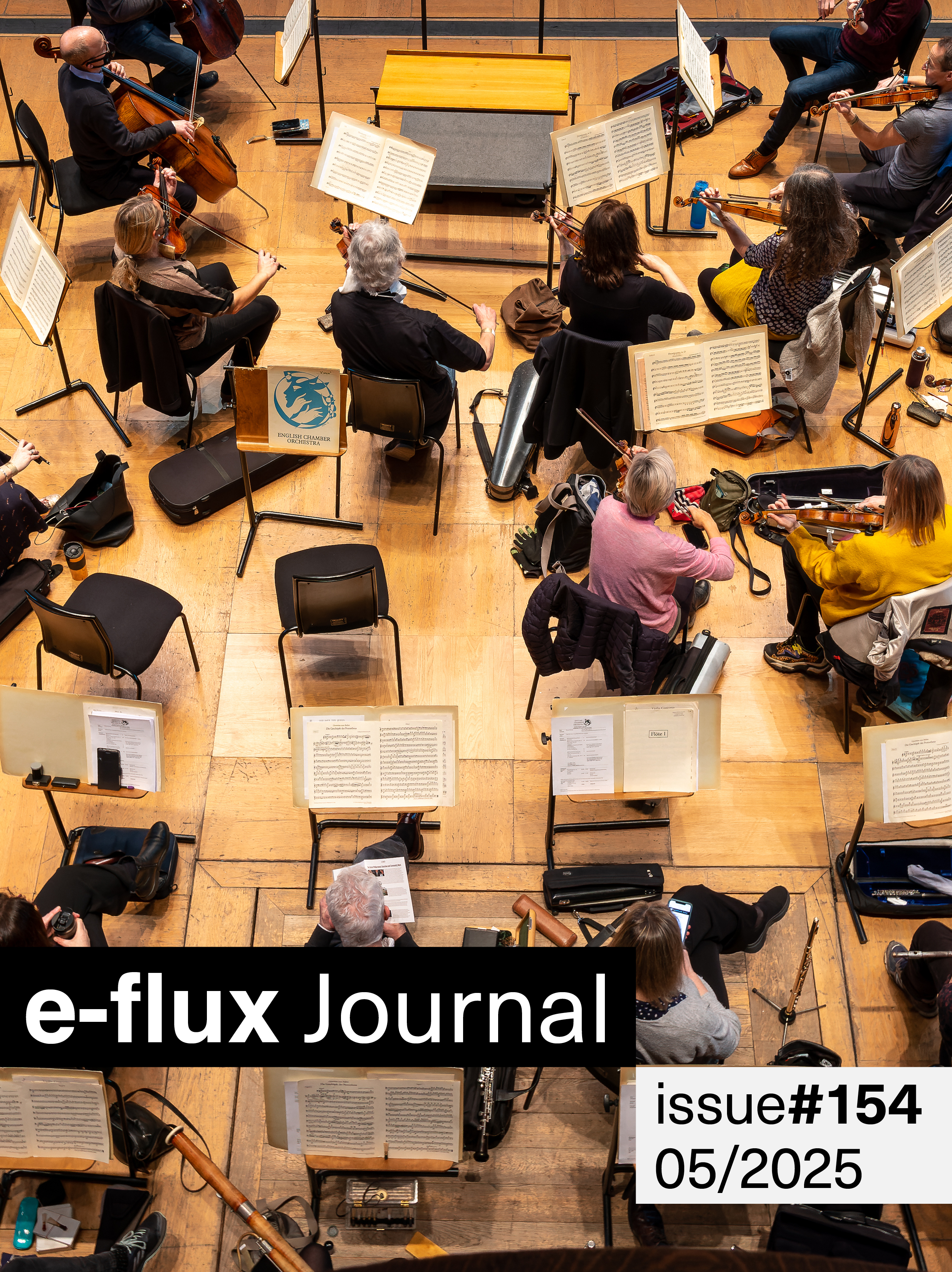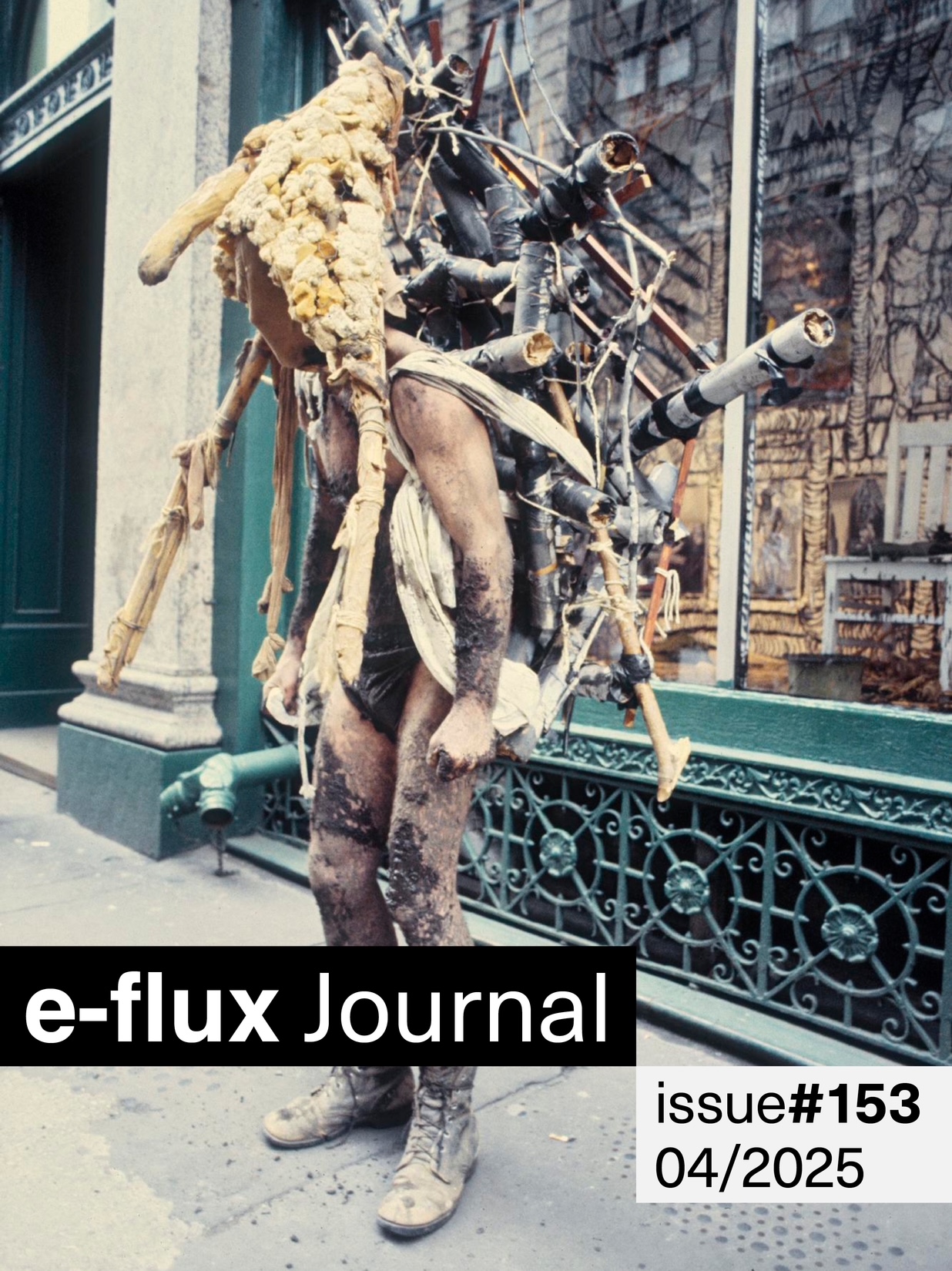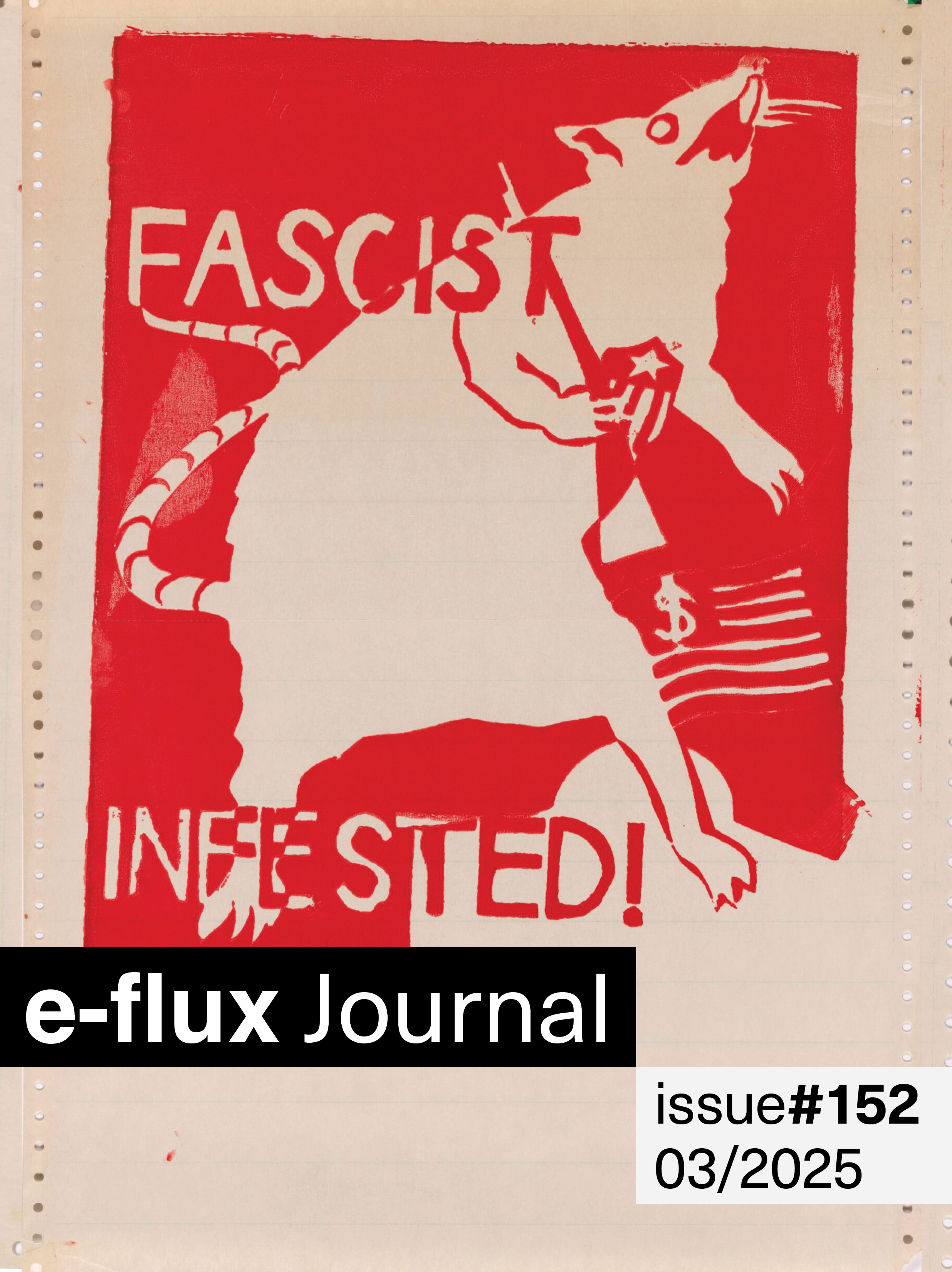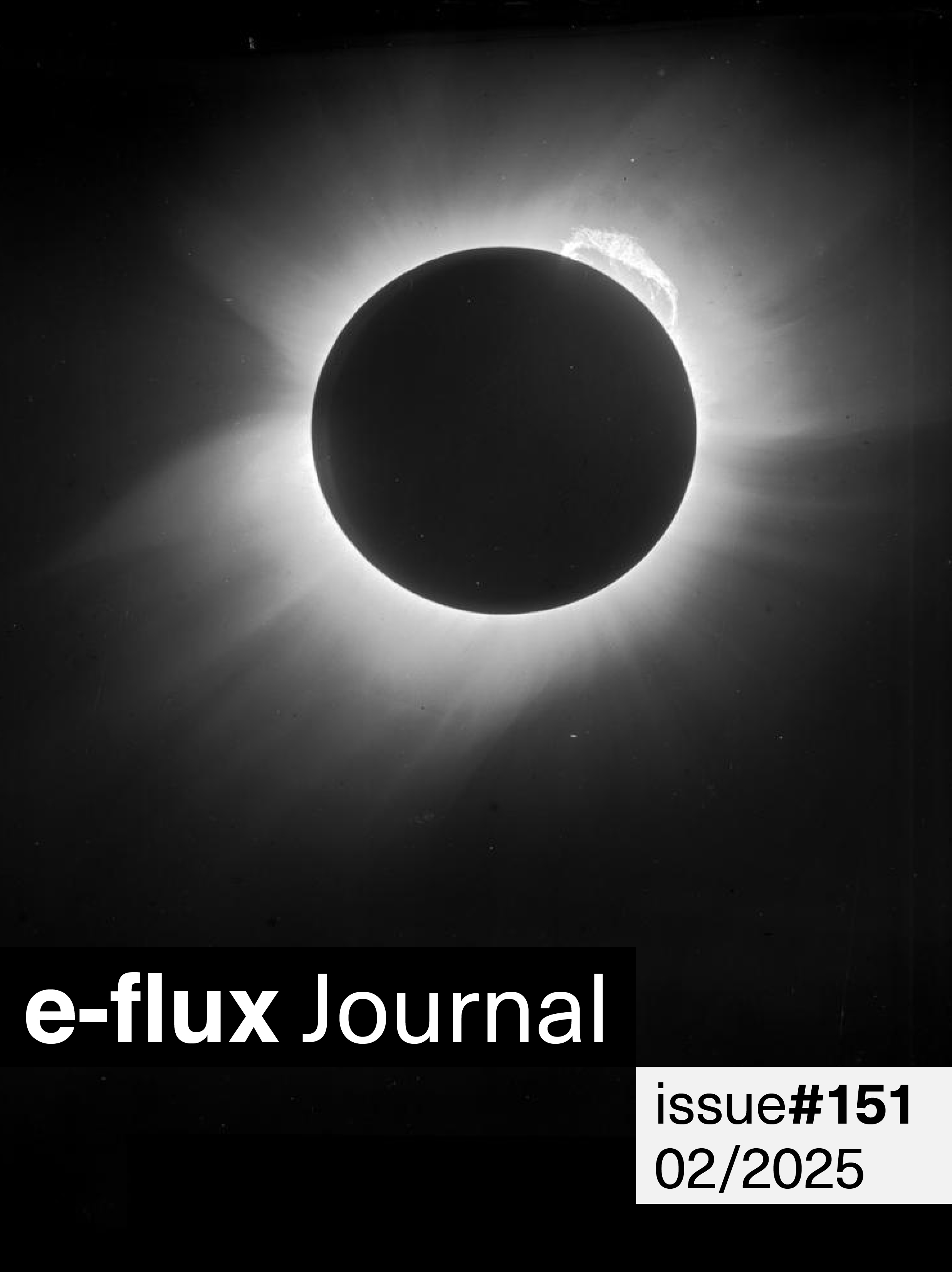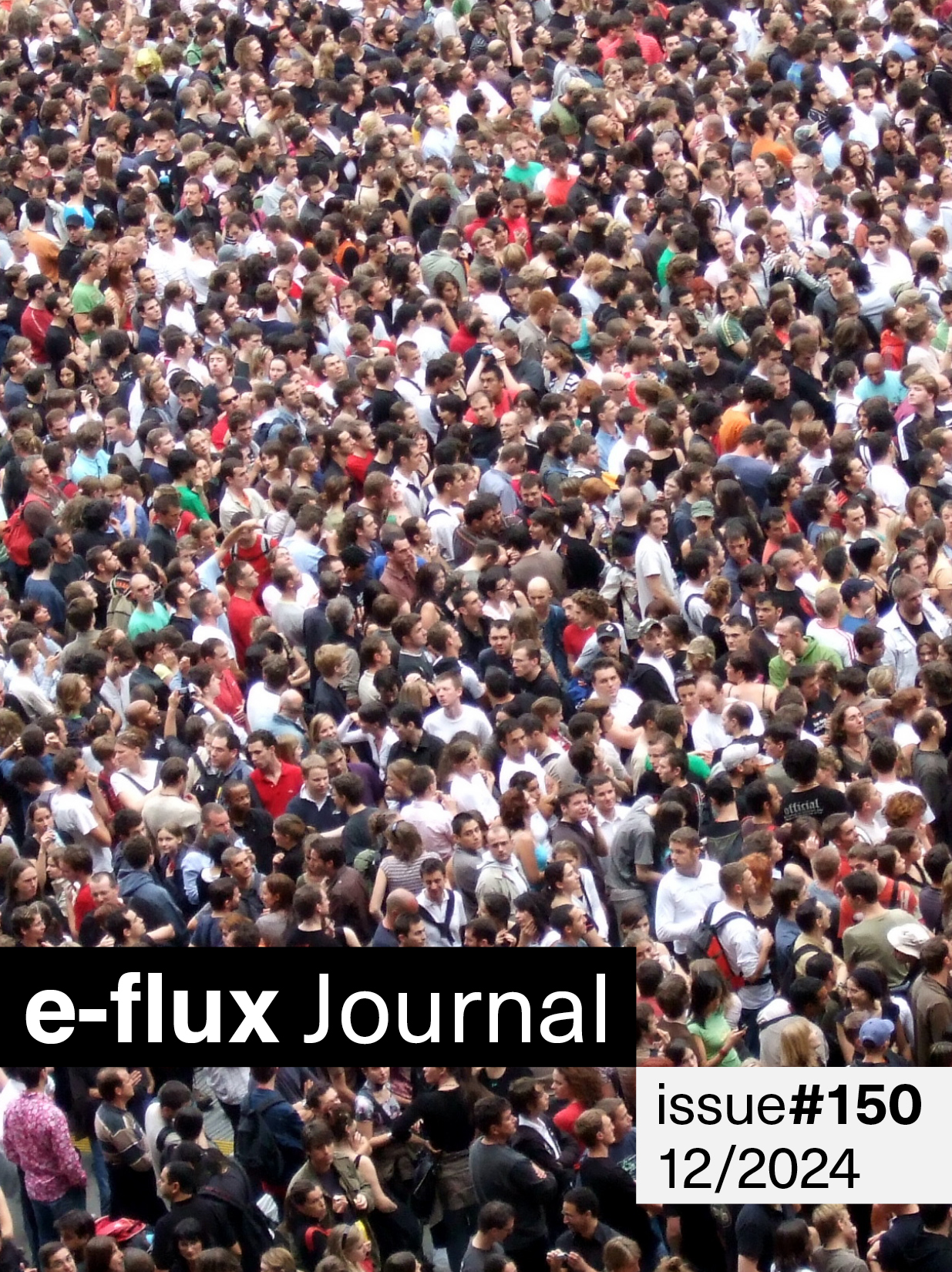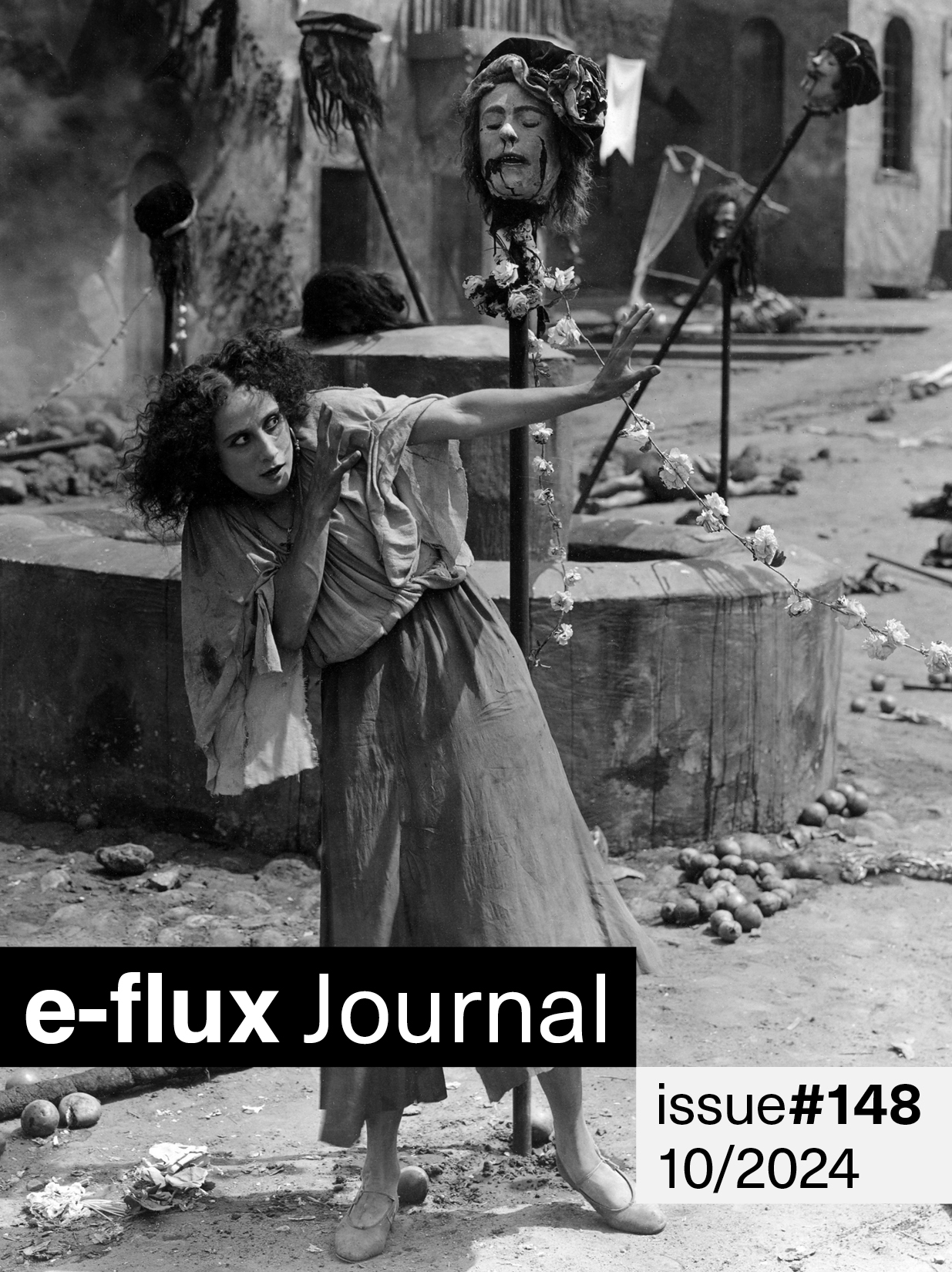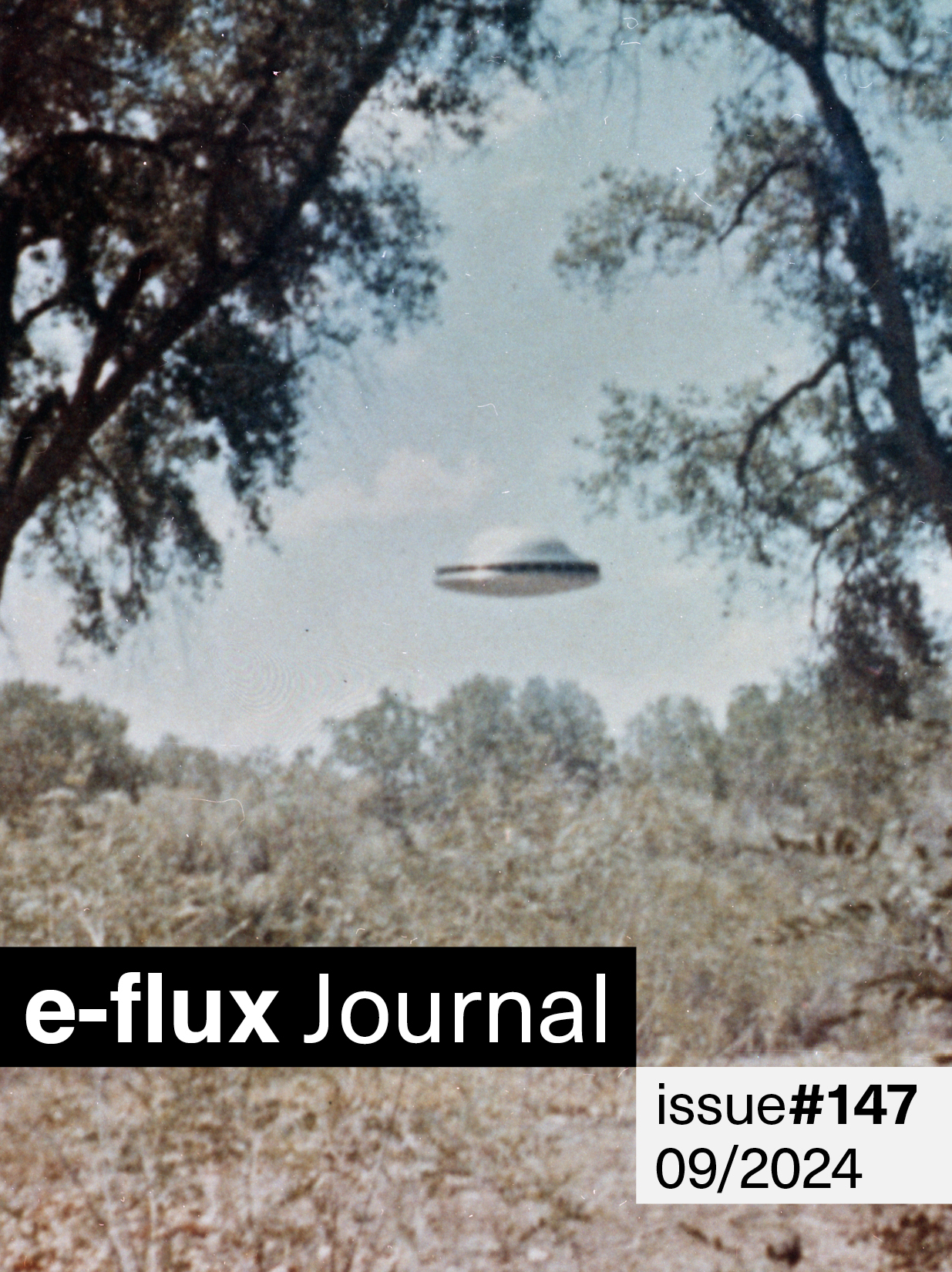e-flux journal issue 97
with Günther Anders, Khaled Saghieh and Marwa Arsanios, Nikolay Smirnov, Ana Hoffner ex-Prvulovic, Kathryn Yusoff, Yazan Khalili, and Kristen Alvanson
As we study the foundations of what we think we know, we might ask: What do we truly know? Mussolini’s regime banned not only words but five entire letters of the alphabet. In 2018, both “immortality” and “migration” were blocked indefinitely in web searches in China. How many letters or words, or even numbers, have been banned in the past? And among those, how many were never remembered again?
In this issue of e-flux journal, Nikolay Smirnov examines the historical left-wing, Marxist splinter of Eurasianism and its merits in the face of contemporary neo-Eurasianist figures who have turned it towards nativist and right-wing agendas. Also in this issue, Khaled Saghieh, in the first essay of a series guest-edited by Marwa Arsanios, recounts the postwar intellectual debates of the 1990s in Beirut as a war of and on memory. A whole city can shift. The memory of what was, or what wasn’t, becomes an intellectual battlefield.
A line of dialogue from Kristen Alvanson’s feverish yet focused sci-fi memoir XYZT, excerpted in this issue, illustrates as follows: “I can tell you what I see, if you’d like.” “What are my injuries?” “Not that kind of seeing.” The person asking about injuries has just been spared from the incomparable red heat of the Dasht-e Lut Desert by a blue Jinn, who dropped the traveler near snowy Sabalan mountain, elsewhere in Iran. Throughout XYZT, via modes technological and magical, persons are able to trade places between the US and Iran, seeing as the other sees. Eyes must be strained to open further toward what’s come before, to where individual or group practitioners of shared artistic projects and shared cultural pursuits currently stand and where they plan to go together.
Geographer Kathryn Yusoff takes the needed step of reexamining the points of origin of the current human era, especially when considered from the history and position of blackness and indigeneity. Bear in mind that the star charts and landmarks calcified in dry stone were etched by people whose views narrowed to accommodate and compliment the stories of those who looked and fought like them. As Yusoff points out, the grammar used in describing geographies of conquest and contact to this day is violently insufficient: “As a descriptive project in the grammar of geology, [the Orbis] spike naturalizes European colonial relations and their epistemological and ecological transformations.” But, she continues, “The Anthropocene cannot dust itself clean from the inventory of which it was made … The shift of grammar cannot keep the rawness out.”
Ana Hoffner ex-Prvulovic peers through orientalist paintings, seeing depicted and out-of-sight structures and realities of slavery therein through refreshed lenses of queerness. She points out that in institutional, art-historical contexts where paintings by the likes of Jean-Léon Gérôme are displayed, there is no language provided to deal with the sexual encounters and possibilities either shown or avoided. Moving through time, Hoffner ex-Prvulovic offers new language around the twentieth-century work of Claude Cahun and twenty-first-century photographer Zanele Muholi, in productive contrast to “the paranoid subject of the present, obsessed with its own fear of eradication and with the global catastrophe that from its point of view has to come.”
We begin to more fully comprehend, via an array of illustrative anecdotes written by Yazan Khalili, the double and triple linguistic and practical binds for artists who are particularly engaged in political work. In Khalili’s text, there is a short saga about a young would-be Muslim asking Mohammad whether God could create a boulder that is impossible for that same creator to lift. In Khalili’s telling, the story’s conclusion is this: “When a power structure has to face itself, when it is confronted with its own language, it enters into a dilemma that it cannot solve. The only way to escape the dilemma it to take away the possibility of posing the question in the first place.”
It seems fair to assume that now represents the far endpoint of many previously held logics developed over the last four-hundred-some years, yet the navigational tools used to move forward have not all accepted this fact. In the case of Günther Anders’s essay in this issue, written in 1959, the urgent task becomes to reformulate our understanding of time, of communism, of eschatology. How might we alter our sedimented ways of looking and speaking in order to arrive at the future?
—Editors
Günther Anders—Apocalypse without Kingdom
Of course, the words “apocalyptic” and “anti-apocalyptic” played no role in the discussions of the category of “progress.” Nonetheless, despite being watered down, the pair of opposites “apocalyptic” and “anti-apocalyptic” is still recognizable in the beloved differentiation between “evolutionary” and “revolutionary.” Who knows if the disgust with which the Americans reacted to Bolshevism and “Soviet Russia” wasn’t caused so much by Communism itself as much as by the fact that the Russian Revolution, which obviously had something apocalyptic about it, served as an extreme rebuff to the American belief that apocalyptic events were unnecessary.
Khaled Saghieh—1990s Beirut: Al-Mulhaq, Memory, and the Defeat
In order for memory to become the new nursemaid of the same leftist tradition, traditional Marxist priorities had to be overturned. Economic transformations no longer formed the underlying basis of Lebanon’s postwar culture; the new principal concern was instead the process of memory erasure, with economic dimensions seen as mere extensions of this process. Thus, in an article that appeared in Rive, a journal published by the Mediterranean Universities Union (UNIMED), and reprinted in Al-Mulhaq, Khoury wrote that the economic dimension of reconstruction, despite its importance, did not represent the essence of what was taking place in Beirut. It is true that a neoliberal economic vision enabled a private company to grab hold of the city center, unleashing rampant real estate speculation, but this was no more than a reflection of the emergence of a prevailing alliance between the major capitalists and the leaders of former militias. As for the basic pillar of this alliance, it was in fact the law of general amnesty, which did not so much grant forgiveness for war crimes as attempt to erase the war itself, leaving only the option to forget. Forgetting was the fundamental condition that permitted the princes of war to become princes of peace.
Nikolay Smirnov—Left-Wing Eurasianism and Postcolonial Theory
Eurasianism had veered leftward by 1927. It seemed at the time it could become a second Soviet ideology, an ideology for the people that would fuse Russian Orthodoxy, statism, and Communist rhetoric. In late 1927, Souvtchinsky suggested making a “temporary transcription of Eurasian doctrine into theoretical terms typical of the Soviet milieu,” that is, engaging in linguistic mimicry and honest-to-goodness entryism by way of infiltrating the Soviet system and transforming it from within. His arguments were rejected by the larger movement, leading the Clamart faction to distance itself from them. The ideologues of left-wing Eurasianism set about reconciling the philosophies of Nikolay Fedorov and Karl Marx. They imagined Russia-Eurasia as the “chrysalis” of a future universal socialism in the Russian mold, a “universal kingdom of truth,” and they believed building it was Russia-Eurasia’s “common cause.” These ideas were roundly rebuffed by the other Eurasianists.
Ana Hoffner ex-Prvulovic—Non-Aligned Extinctions: Slavery, Neo-Orientalism, and Queerness
In any other situation, this story might be an accepted and rather boring part of lesbian life, maybe even a welcome sign of neoliberal excess and playfulness. However, I found it difficult to associate this memory with the context of slavery. It felt almost impossible to acknowledge that I could easily identify with the slave trader examining a woman’s teeth. Since the museum text did not address the dimension of sexuality at all, there seemed to be no language for the obviously sexual relations in the painting, only a silent repetition of the “disturbing” moment of the scene. In fact, the institution’s text suggested a reception of the painting quite similar to its function in 1866: slavery has to be watched with secret and speechless arousal.
Kathryn Yusoff—White Utopia/Black Inferno: Life on a Geologic Spike
Nuclear testing marks the displacement and exposure of indigenous peoples in the Pacific Islands and the radiation of Native American and Aboriginal peoples in North America and Australia. Many islanders in the Pacific were moved and removed during US nuclear tests. Bikini Atoll, for example, was subjected to thirty years of nuclear explosions, during which time islanders were moved to a range of islands. Islanders in the Atolls were both proximate to the nuclear fallout, where they were exposed to radioactive ash, and moved to uninhabitable islands, where islanders “sucked stones” to keep hunger at bay, and starvation was common. Many returned to Bikini Island, despite the contamination of its water sources and foodstuffs, because the uninhabited islands to which they were moved were uninhabited for a reason. Islanders on Rongelap and Utrok exposed by the Bravo detonation were subject to immediate radiation from the blasts and suffered visible burns, causing both immediate and lasting epidemiological legacies and toxic intimacies with leukemia, neoplasms, and thyroid cancers. The white powder of irradiated coral dust that fell throughout the Atolls was dangerously radioactive. Not recognizing this new material substance, children played in it. As Maori poet Hone Tuwhare’s 1964 poem goes, this was “No Ordinary Sun.”
Yazan Khalili—Freedom of Speech, Freedom of Noise
In the case of “The Museum of Resistance in Exile,” art practices and art exhibitions were regarded as vehicles for political action and solidarity. Artworks themselves spoke politics, and spoke even louder when shown together. The exhibition acknowledged that every political struggle must also be a cultural struggle—that resistance movements can be supported and advanced by artistic and cultural practices that treat art and culture as themselves fields for political struggle.
Kristen Alvanson—XYZT
Further from the center, the stories become less straightforward. Less straightforward! Two women with head coverings share a mysterious round item, passing it back and forth. A man in blue carries firewood on his back, held there with strings. He must have come down from the high rocks, past the orange tree. A musician tries to sell a silver container with stones embedded on the top to a man with a rearing horse. Flying through the scene, a chunky albino demon with horns waves a staff in its hand. A couple of men barter over a bulbous copper vessel. The buyer wears a small purse embellished with gold embroidery hanging from a chain. A zoned-out man stands holding a long pipe that touches the ground—the way he is holding it, at first it looks like a golf club. Birds hide in trees holding private conferences. A see-through square, next to the long rectangle filled with a navy-blue floral pattern, next to a bigger see-through rectangle … all taking up visual space at the edge of the story. Will they be populated sometime in the future? I wait, nothing changes. I start to become overwhelmed by the effort of keeping track of the scene, all the details. Rose ice going to my head. A shifty camel looking east, and opposite, another one, just as shifty, looking west.
